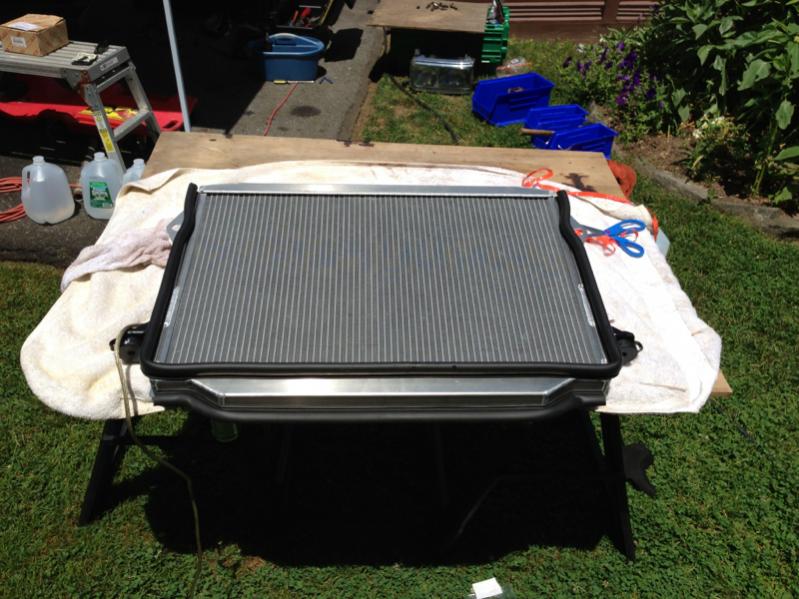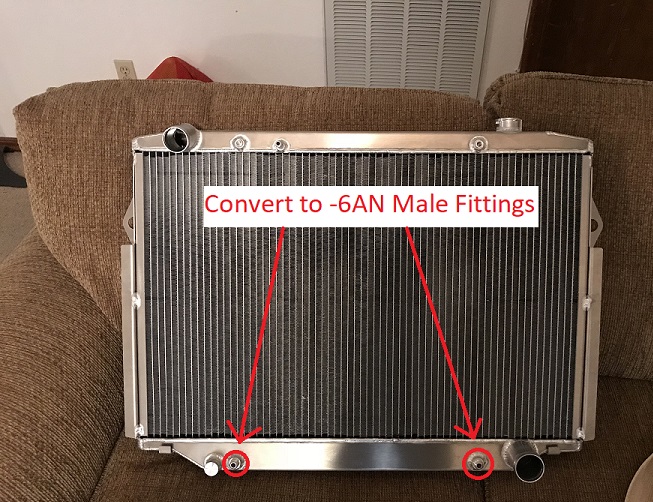Just curious but why? Other than Texas which is an ok answer but lots of good results with an OEM rad at about 1/3 the cost ..... plus it comes with the foam you were inquiring about as well.
Also your pic heavy posts make you a great candidate for a silver star membership

I have coveted a Ron Davis Racing radiator for a long time. Albeit, in a different application. When I found out they made a drop-in replacement for the 80, I decided to splurge. I definitely don't
need an RDR radiator, any more than I
need a Land Cruiser (or any other big-boy toys). I bought it because it's an engineering work-of-art, and is hopefully the last radiator I will ever buy. It's total overkill and overbuilt, and that's why I like it.
Hell, just look at some of their other work.
Assuming that I take care of the other cooling system components (water pump, radiator hoses, fan/clutch, shroud, thermostat, etc.), the cooling system should be extremely capable, regardless of the conditions.
I use lots of pics because I think people pay more attention to posts with pictures. I'm trying to get the benefit of some of the experience other members have here, and pics are an easy way to get people looking. Plus, I think threads with pictures are entertaining.
I'm not sure what a silver membership is, but I'm happy to give back to Mud and upgrade!
Contaminated trans oil is not the only downside of the thru rad cooler, but I personally prefer to keep this system if your in a colder environment. In severely hot climates then it adds load to the cooling system, and fitting a stat on the trans cooler lines starts to move outside preventative maintenance.
Unfortunately we cannot rely on design decisions made by Mr T back in the 1980's to keep our 80's reliable.
Automatic transmission overheating is not uncommon in the 80, Toyota even fitted a light to let you know the original design may not be sufficient to keep it cool when the going gets tough.
Similarly the stock engine cooling whilst not quite marginal, does have issues, a non modified temperature gauge will not show problems until it is often much too late.
To this end, I think as individuals we need to look at what we personally do with our vehicles, (and where we do it), is where the decision to modify or not is made.
Regards
Dave
I specifically asked Ron Davis about the additional load on the cooling system from the OEM design (transmission fluid through the radiator) vs. deleting the trans fluid through the radiator and running ATF straight to the liquid to air cooler on the front of the truck (non-OEM design). They said the difference in heat load on the cooling system was negligible.
I think if the thread was, "My plastic radiator end tank cracked. I'm replacing it with a new Toyota OEM radiator. Should I delete the ATF coolant lines to the OEM radiator at the same time?", the answer would be a resounding, "No." That response shouldn't change just because I've purchased a Ron Davis.
It's really interesting, my other project is a 1990 Nissan 300ZX Twin Turbo. All of the guys on TT.net really want a state-of-the-art McCulloch radiator ($$$$$$) with a built in engine oil heat exchanger. The touted benefits are that the engine oil comes up to temperature more quickly with the radiator fluid acting as a thermal bath, and the temp of the oil is more stable. No big spikes or drops in temp due weather conditions. Because there is so much radiator fluid volume, it would take a massive amount of heat energy to change either the oil temp or the water temp. Potential contamination and heat load was just a calculated risk for an overall greater benefit at the track.
Fast-forward to Mud, and guys are suggesting to delete the trans fluid in the radiator, because it might get contaminated or place too much heat load on the radiator. They're deleting the Toyota technology that the Nissan guys are paying a premium for. Hahaha!
Overall I think the ATF fluid through the radiator is a good idea. It brings the trans fluid up to temp more quickly, and keeps the temp more stable. Plus, that's the way Toyota designed it, and even if it's old technology, it seems to work well. I'm going to add a water temp gauge, drive the truck, and go from there.
I have never heard or read reports of the 80 series trans running hot. All info I have read indicates quite the opposite and to see my own trans temp gauge above 150-160F is rare and it usually runs 140F.
Any auto trans can get hot which is why they all have a temp warning light circuit.
Running the trans fluid through the engine cooling system isn’t just for quicker trans fluid warm up. This fluid routing helps to adjust the fluid temp to and temperature that is more of a known constant and which the fluid to air cooler is capable of then adjusting to what the engineers wanted. Trans fluid to water cooling is much more rapid and effective than fluid to air.
I don’t really believe that the air to fluid cooler could do the job as a stand alone unit when the trans is being taxed extremely, due to the fact that the torque converter is capable of heating trans fluid to much higher temps than the engine normally runs.
In summation: I believe that routing the trans fluid through the radiator plays an important roll in controlling trans fluid temps at both extremes of the operating range.
@Will Van - it’s not that silicone hoses leak in the traditional sense, it’s that water will actually penetrate the wall of a silicone hose and water (not glycol) content in the system will be reduced. For this reason, fleet owners/operators do not use silicone hoses.
For us, this is probably not a significant issue, I just can’t think of or remember one reason to pay the premium to have silicon hoses.
I agree, I'm keeping the trans plumbing through the radiator.
I had silicone hoses on my 300ZX. The radiator hoses would never weep, but I could just never get them to seal properly at the clamps. I had forgotten about it until you warned against using them. I've never seen them weep before. Either way, I'm using OEM rubber.
I agree the trans oil going through the cooler/heater is a great way to regulate the temp but they do overheat.
Going back to my previous post, it depends WHAT your doing and WHERE your using your 80, and guess there are no problems for the typical user.
Regards
Dave
What overheats? The transmission fluid or the water temp?
I plan to use the truck as my Sunday driver for day trips around Central Texas. I have a place on the lake that has a very serious trail. My 4WD Tacoma won't make it.
I also plan to drive it across the country and perhaps tow a trailer - Cruise Moab, FJ Summit in Ouray, Grand Teton NP, Big Sur, Grand Canyon, etc. The truck will see some 4WD time for sure. But probably nothing more serious than a 5 or 6. I don't want to tear it up or damage the bodywork.
Thanks for all of the help guys!!!

















